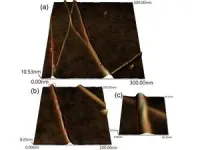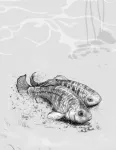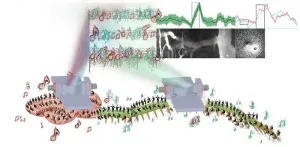(Press-News.org)
Ikoma, Japan – With the growth of the Internet of Things, sustainable solution for powering wireless sensors and devices are considered important. Thermoelectric generators, for example, which have the ability to convert waste heat into electricity can offer a sustainable solution. Researchers around the world have been working on such solutions. A research team, led by Masakazu Nakamura from Nara Institute of Science and Technology (NAIST), Japan has also been working on flexible wearable thermoelectric generators that produce electricity from body heat by sewing nanomaterial called carbon nanotubes (CNTs) into fabric.
Effective thermoelectric (TE) materials are characterized by high electrical conductivity enabling high electrical current and large Seebeck coefficient generating voltage by temperature difference. CNTs meet most of these requirements. Their flexibility and high mechanical strength also make them promising for various TE applications. However, the high thermal conductivity of CNTs limits their TE performance. To lower their thermal conductivity, CNTs are dispersed in a solution where they can be combined with other materials. This dispersion is then spun into CNT yarns using a wet-spinning process. However, conventional dispersion methods often entangle nanometer-thick CNT filaments, which lowers their electrical conductivity and thermoelectric performance.
Now, however, in a study published in ACS Applied Nano Materials, Nakamura, along with a PhD student Anh N. Nguyen and other members also from NAIST, introduced a new method for dispersing CNTs. By utilizing glycerol as a dispersant and polyoxyethylene(50) stearyl ether as a surfactant (a substance used to improve the spreading and wetting properties of a liquid), the researchers achieved a CNT yarn with aligned CNT bundles.
“We introduce a low-cost, fast, and environmentally friendly method for the development of flexible and fabric-type wearable thermoelectric devices,” says Nakamura.
Glycerol is highly viscous, making it an excellent medium for evenly dispersing CNTs, while the surfactant prevents the CNTs from agglomerating in the dispersion. The surfactants with oxyethylene groups also impede heat transfer by getting in between the CNT bundles.
The concentration of surfactant is crucial, as it influences both the thermal and electrical conductivity of the CNT dispersion. After testing CNT properties at various surfactant concentrations (3%, 4%, and 5%), researchers found that a 3% surfactant concentration, when combined with a solution containing glycerol and CNTs, gave the best results. The process, which only took three hours to complete and used ecofriendly chemicals, produced CNT yarn with highly aligned eight nm diameter CNT bundles with surfactant between them.
Aligning the CNTs typically increases both the electrical and thermal conductivity. However, by sandwiching surfactant molecules between CNT bundles, researchers were able to suppress heat transport. The CNT yarns had a power factor of 242 μW m−1 K−2 (reflecting performance) three times higher than that of CNT yarns previously obtained from methods that use ionic liquids as dispersants.
“The key to high performance is to unravel the entanglement of the raw CNT material and increase the degree of CNT orientation when spun from the dispersion,” explains Nakamura.
Thus, the proposed novel approach holds promise for enhancing the thermoelectric performance of CNT materials from yarns to films and bulk structures.
###
Resource
Title: Carbon nanotube yarns tailored using dispersants and surfactants for flexible and wearable thermoelectric generators
Authors: Anh N. Nguyen, Naofumi Okamoto, Ryo Abe, Aghnia D. M. Heriyanto, Nikita Kumari, Gilbert Pado, Shuto Tanimura, Yongyoon Cho, Manish Pandey, Hiroaki Benten, Masakazu Nakamura
Journal: ACS Applied Nano Materials
DOI: 10.1021/acsanm.4c00497
Information about Laboratory for Organic Electronics can be found at the following website: https://mswebs.naist.jp/LABs/greendevice/www/index_e.html
About Nara Institute of Science and Technology (NAIST)
Established in 1991, Nara Institute of Science and Technology (NAIST) is a national university located in Kansai Science City, Japan. In 2018, NAIST underwent an organizational transformation to promote and continue interdisciplinary research in the fields of biological sciences, materials science, and information science. Known as one of the most prestigious research institutions in Japan, NAIST lays a strong emphasis on integrated research and collaborative co-creation with diverse stakeholders. NAIST envisions conducting cutting-edge research in frontier areas and training students to become tomorrow's leaders in science and technology.
END
The authors of a major study on the Critically Endangered Arabian leopard say that the release of captive bred animals carefully selected for their genes can make a significant contribution to the successful recovery of the dwindling wild population and avert the prospect of extinction.
An international collaboration led by scientists from the Durrell Institute of Conservation and Ecology (DICE) at the University of Kent, University of East Anglia (UEA), University College London (UCL), Nottingham-Trent University (NTU) and the Diwan of Royal Court in Oman, surveyed the remote Dhofar mountain range of southern Oman to determine how many of Arabia’s last big cat survive.
By ...
For Wendy Hood and Geoffrey Hill in Biological Sciences, Andreas Kavazis in Kinesiology, and their team, Emma Rhodes, Paulo Mesquita, and Jeff Yap, traveling the country to unlock the mystery of mitochondria in migrating aviary species has allowed them to make a significant contribution to research in an area that has not been investigated before. The first publication conducted in the AU MitoMobile van is featured in Scientific Reports, “Flexibility underlies differences in mitochondrial respiratory performance between ...
BIRMINGHAM, Ala. – Chronic obstructive pulmonary disease patients with type 2 inflammation may soon gain access to a new drug — dupilumab — that showed rapid and sustained improvements in patients in a pivotal Phase 3 clinical trial, researchers report in the New England Journal of Medicine. This monoclonal antibody is the first biologic shown to improve clinical outcomes in COPD. The data supporting the use of dupilumab in COPD will be reviewed by the United States Food and Drug Administration in June.
The disease improvements — as measured by a significantly ...
Embargoed for release until 5:00 p.m. ET on Monday 20 May 2024
Annals of Internal Medicine Tip Sheet
@Annalsofim
Below please find summaries of new articles that will be published in the next issue of Annals of Internal Medicine. The summaries are not intended to substitute for the full articles as a source of information. This information is under strict embargo and by taking it into possession, media representatives are committing to the terms of the embargo not only on their own behalf, but also on behalf of the organization they represent.
----------------------------
1. ...
Purdue-led fishing expedition nets new pupfish family member in New Mexico
Genetic drift, not natural selection, identified as main factor driving speciation
WEST LAFAYETTE, Ind. Scientists have identified a new member on the genetic family tree of an endangered pupfish native to south-central New Mexico.
“We went into this thinking that there was one species of conservation concern,” said J. Andrew DeWoody, professor of genetics in Purdue University’s Department of Forestry and Natural Resources. “The preponderance of evidence ...
BOSTON--Yoga, mindfulness, meditation, breathwork, and other practices are gaining in popularity due to their potential to improve health and well-being. The effects of these practices are mostly positive and occasionally transformational, yet they are known to sometimes be associated with challenging altered states of consciousness.
New research by a team including investigators from Massachusetts General Hospital, a founding member of the Mass General Brigham healthcare system, reveals that altered states of consciousness associated with meditation practice are far more common than expected.
Although many people reported positive outcomes, that were sometimes even considered ...
Cislunar space, which stretches from the Earth to just beyond the moon’s orbit, is about to become heavily trafficked over the next 10 years. With NASA’s planned Artemis missions and other countries joining in the cislunar space race, there’s an interest in observing, tracking and predicting the orbit of objects like asteroids and satellites so they don’t collide with spacecraft.
But the process of detecting and observing space objects, known as space domain awareness (SDA), faces challenges with the extensive volume of cislunar space.
“Cislunar space is vast,” says Tarek Elgohary, an associate professor ...
A sensory process such as pain is no ordinary phenomenon—it’s a symphony of neural and vascular interactions orchestrated by the brain and spinal cord. Attempting to dissect this symphony by focusing on a single region is like trying to understand a complex melody by listening to just one instrument. It’s incomplete, potentially misleading, and may result in erroneous conclusions.
Enter the Carney Institute’s team of visionaries. Their mission? To develop tools that allow unprecedented observation of neural and vascular activity within the brain and spinal cord. They tackled two critical fronts: imaging hardware and bioluminescent (BL) molecular tools.
Innovative ...
A certain biological pathway, a set of linked reactions in the body, drives the inflammation seen in the skin disease psoriasis, a new study finds. The work could lead to improved therapies for all inflammatory skin diseases, including atopic and allergic dermatitis and a type of boil called hidradenitis suppurativa, say the study authors. Inflammation is the body’s natural response to irritation and infection, but when out of control, it can lead to the reddish, flaky, itchy lesions that come with these skin diseases.
Led by researchers at NYU Langone Health, the new study found that the interleukin-17 (IL-17) pathway, ...
Research Assistant Professor Christopher Fowler received the NASA 2023 Planetary Science Early Career Award for his project “Bringing Planetary Science to West Virginia”. The award is based on demonstrated leadership, involvement in the planetary science community, and potential for future impact.
The resources provided by the NASA Planetary Science Early Career Award will allow Fowler and team to undertake research-related activities that are not always possible within the scope of more “traditional” ...






